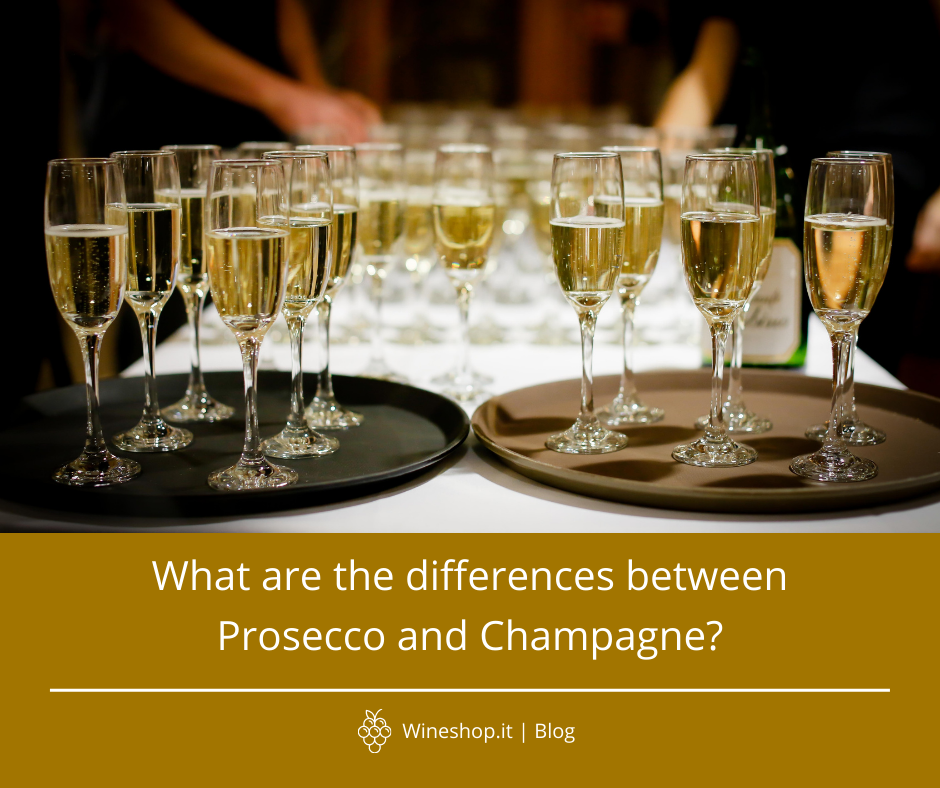What are the differences between Prosecco and Champagne?
This question may not be easy to answer: what is the difference between Prosecco and Champagne? What aspects distinguish them?
These two sparkling wines are often confused. For this reason, we have decided to write an article in which we explain the big difference that exists between Prosecco and Champagne.
We have organized our short guide in 4 paragraphs to highlight 4 characteristics that distinguish the two wines: production area, grape varieties, production method and organoleptic properties.
If you want to try them, choose our online shop. You can find bottles of Prosecco, because we sell Italian wines, but we also have one of the latest and most prestigious "artisanal" Champagne in the world (Magnum format).
Differences between Prosecco and Champagne: production area
The first difference concerns the production area of these wines. Everyone would say Italy and France. If we go into detail, we can say that Prosecco is produced in northeastern Italy, in some areas of Veneto and Friuli Venezia Giulia. Champagne, on the other hand, is produced in the historical region of Champagne in France (Champagne-Ardennes), located in the north-eastern part of the country.
Differences between Prosecco and Champagne: grape varieties
The second difference concerns the vines at the base of the production of these wines. If we asked you: what are the Prosecco grapes? What are the Champagne grapes? Are you able to answer?
Let's start with Prosecco. The Prosecco grapes are those of the Glera white grape variety. Lots of producers use it in purity.
The denomination "Prosecco" establishes these percentages: at least 85% of Glera grapes plus a possible 15% of grapes from other vines such as Verdiso, Bianchetta trevigiana, Perera, Chardonnay, Pinot bianco, Pinot grigio and Pinot nero (vinified in white).
Champagne is obtained from the three main grape varieties of the region: Chardonnay, Pinot Noir and Pinot Meunier. Depending on the characteristics of the wine they intend to produce, wineries can decide to use all or part of these vines.
Among the vines authorized to produce Champagne there are four others, less used: Arbanne, Petit Meslier, Pinot Blanc and Pinot Gris.
Differences between Prosecco and Champagne: production method
The third difference between Prosecco and Champagne is the production method.
Prosecco is produced using the Martinotti or Charmat method, with the second fermentation of the base wine, necessary to produce the classic bubbles, which takes place in an autoclave.
We must say that Prosecco can also be produced using the Classic Method, but the bottles obtained with this technique are much less than those with the Martinotti method.
Champagne is produced only with the Classic Method or Champenoise Method, with the refermentation of the base wine in the bottle.
This method is more expensive. The wine has a higher aging potential than those produced with the Martinotti Method. For this reason, while Prosecco is a wine to drink early, Champagne can be aged for a few years.
Differences between Prosecco and Champagne: organoleptic characteristics
The last difference concerns the organoleptic properties of the two wines.
Prosecco is floral (white flowers) and fruity (apple, pear, exotic fruit and citrus). Primary aromas prevail on the nose as a result of the refermentation in autoclave and the brief contact with the lees and yeasts. The taste is fresh, light, pleasant and lively.
Champagne is more complex and varied, with primary aromas that blend with the secondary and tertiary ones (with the classic toasted, bread crust and yeast scents), due to contact with lees and yeasts and the aging period.
Its characteristics depend a lot on the vines used to produce it, from the more delicate notes and the lightness of the Chardonnay to a greater aromatic and structural complexity with Pinot Noir and Pinot Meunier.
Now you know the main differences between Prosecco and Champagne.
If you liked our article and if you want to continue to receive news, updates and curiosities about the world of wine, subscribe to the Wineshop.it wine newsletter. Lots of content and offers await you!









